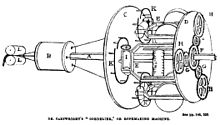Power loom
Cartwright designed his first power loom in 1784 and patented it in 1785, after some contact with textile men from Manchester; its value was only in proof of concept, but the type of design continued into the 20th century. Subsequent research and development work by others is now given much of the credit for a practical powered loom. In 1809 Cartwright obtained a grant of £10,000 from parliament for his invention.
In 1789, Cartwright patented another loom which served as the model for later inventors to work upon. For a mechanically driven loom to become a commercial success, either one person would have to be able to attend to more than one machine, or each machine must have a greater productive capacity than one manually controlled. He added improvements, including a positive let-off motion, warp and weft stop motions, and sizing the warp while the loom was in action. He commenced to manufacture fabrics in Doncaster using these looms, and discovered many of their shortcomings. He attempted to remedy these in a number of ways: by introducing a crank and eccentric wheels to actuate its batten differentially, by improving the picking mechanism, by means of a device for stopping the loom when a shuttle failed to enter a shuttle box, by preventing a shuttle from rebounding when in a box, and by stretching the cloth with temples that acted automatically. His mill was repossessed by creditors in 1793.
In 1792, Cartwright obtained his final patent for weaving machinery; this provided his loom with multiple shuttle boxes for weaving checks and cross stripes. All his efforts were unavailing, however; it became apparent that no mechanism, however perfect, could succeed so long as warps continued to be sized while a loom was stationary. His plans for sizing them while a loom was in operation, and before being placed in a loom, failed. These problems were resolved in 1803, by William Radcliffe and his assistant Thomas Johnson, by their inventions of the beam warper, and the dressing sizing machine.
In 1790 Robert Grimshaw of Gorton, Manchester erected a weaving factory at Knott Mill which he intended to fill with 500 of Cartwright's power looms, but with only 30 in place the factory was burnt down, probably as an act of arson inspired by the fears of hand loom weavers. The prospect of success was not sufficiently promising to induce its re-erection.
In May 1821, Cartwright was elected a Fellow of the Royal Society.

